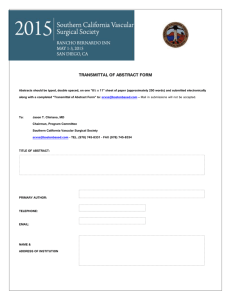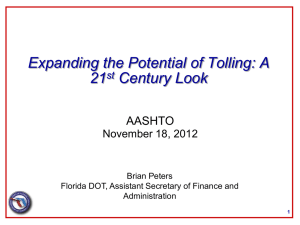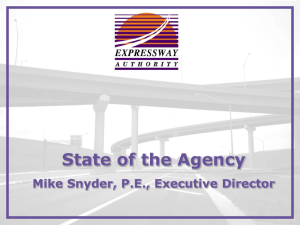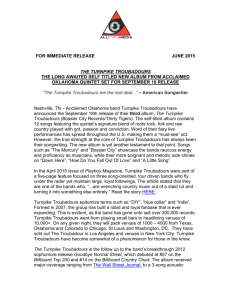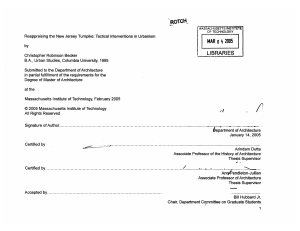The Turnpike was requested to evaluate the
advertisement
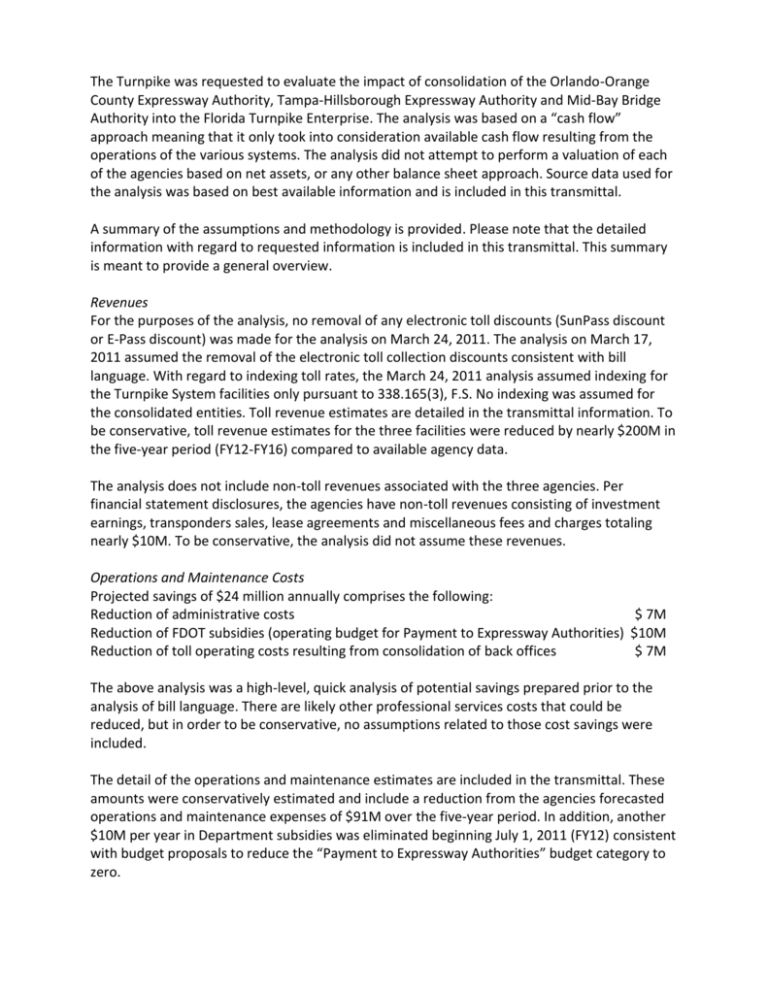
The Turnpike was requested to evaluate the impact of consolidation of the Orlando-Orange County Expressway Authority, Tampa-Hillsborough Expressway Authority and Mid-Bay Bridge Authority into the Florida Turnpike Enterprise. The analysis was based on a “cash flow” approach meaning that it only took into consideration available cash flow resulting from the operations of the various systems. The analysis did not attempt to perform a valuation of each of the agencies based on net assets, or any other balance sheet approach. Source data used for the analysis was based on best available information and is included in this transmittal. A summary of the assumptions and methodology is provided. Please note that the detailed information with regard to requested information is included in this transmittal. This summary is meant to provide a general overview. Revenues For the purposes of the analysis, no removal of any electronic toll discounts (SunPass discount or E-Pass discount) was made for the analysis on March 24, 2011. The analysis on March 17, 2011 assumed the removal of the electronic toll collection discounts consistent with bill language. With regard to indexing toll rates, the March 24, 2011 analysis assumed indexing for the Turnpike System facilities only pursuant to 338.165(3), F.S. No indexing was assumed for the consolidated entities. Toll revenue estimates are detailed in the transmittal information. To be conservative, toll revenue estimates for the three facilities were reduced by nearly $200M in the five-year period (FY12-FY16) compared to available agency data. The analysis does not include non-toll revenues associated with the three agencies. Per financial statement disclosures, the agencies have non-toll revenues consisting of investment earnings, transponders sales, lease agreements and miscellaneous fees and charges totaling nearly $10M. To be conservative, the analysis did not assume these revenues. Operations and Maintenance Costs Projected savings of $24 million annually comprises the following: Reduction of administrative costs $ 7M Reduction of FDOT subsidies (operating budget for Payment to Expressway Authorities) $10M Reduction of toll operating costs resulting from consolidation of back offices $ 7M The above analysis was a high-level, quick analysis of potential savings prepared prior to the analysis of bill language. There are likely other professional services costs that could be reduced, but in order to be conservative, no assumptions related to those cost savings were included. The detail of the operations and maintenance estimates are included in the transmittal. These amounts were conservatively estimated and include a reduction from the agencies forecasted operations and maintenance expenses of $91M over the five-year period. In addition, another $10M per year in Department subsidies was eliminated beginning July 1, 2011 (FY12) consistent with budget proposals to reduce the “Payment to Expressway Authorities” budget category to zero. Long-Term Debt The analysis assumed all existing debt service repayment schedules associated with each agency. To be conservative, no assumptions were made with regard to projected savings from debt restructuring for the March 24, 2011 analysis. The March 17, 2011 analysis included a nominal amount related to refinancing savings. Initially, the savings were due to two factors: 1) recent savings resulting from Turnpike debt refinancing and 2) the inclusion of Santa Rosa Bay Bridge Authority in the initial draft language. It should be noted that the last two Turnpike refinancings resulted in an average debt service savings of approximately $1.35M per year each. No TFRTF loan repayments were considered in the analysis since draft bill language provides that repayments of TFRTF loan obligations will be deposited into the Turnpike General Reserve. As such, the assumption is a net impact of zero related to TFRTF repayments. All other loan repayments were assumed to be in accordance with proposed bill language. Projected bond sales were based on Turnpike’s debt management policy – i.e. 30-year fixedrate level debt. The debt management policy has been included in the detailed transmittal for reference. Interest rates for future debt issuances were estimated at 5.5%-6.0%. The 2010B Florida’s Turnpike new money sale in May 2010 resulted in a 4.5% true interest cost (TIC). The analysis assumed higher interest rates due to current market conditions. Current municipal market yields range from 5%-6% for “AA” and “A” credits. Bond issuances to support capacity projects: FY12 $139M FY13 $410M FY14 $1,624M FY15 $425M FY16 $160M Projects/Capital Plans Included in this transmittal is the information relative to each agency’s Capital Plan that was used in the analysis. Mid-Bay- reviewed the 2009 Capital Improvement Program to determine capital and Renewal and Replacement (R&R) projects. The Mid-Bay Connector (Phases 1-3) is underway and has been funded. The analysis assumed no changes related to this project. It also assumed unspent bond proceeds would be available for funding the project and incorporated the debt service associated with the outstanding debt into the cash flow analysis. THEA- reviewed the March and August 2010 Finance Plans to determine capital and R&R project commitments. The analysis assumed the joint funding with the Department/D7 for the 1.25 mile widening and deck panel replacement on SR618 would continue unaffected. The analysis assumed that the planned 2011 bond sale related to this funding would be executed prior to consolidation, and therefore, the analysis assumed the debt service as incorporated into the THEA Finance Plan. The Gandy Connector was not incorporated into the 5-year Work Program as it would need to be evaluated as an expansion project pursuant to statutory guidelines. OOCEA- reviewed the FY2011-2015 Work Plan to determine capital and R&R project commitments. A total of $678M in projects was incorporated into the analysis. The Wekiva project was not incorporated into the 5-year Work Program as it would need to be evaluated as an expansion project pursuant to statutory guidelines. Projects included: SR414 (John Land Apopka) improvements System improvements – interchanges, widenings, etc. Toll Facility improvements Roadway improvements (ITS, signing, pavement marking, landscaping) Project Capacity- The Turnpike did not evaluate, identify or program potential projects in the Work Program relative to capacity. The financial analysis merely evaluated the resources available for project programming. The financial analysis did include the project revenues from a hypothetical project opening outside the 5-year Work Program period averaging $12M per year in the second 5-year period. No change to the existing statutory and procedural process for identifying and prioritizing projects was assumed. We have included a pictorial in this transmittal that provides a high-level overview of the Work Program cycle. County Spending Provisions The Senate Budget Subcommittee edited bill language to include provisions to ensure that revenues collected net of outstanding obligations (primarily debt service, operations and maintenance costs, and R&R costs) within the respective counties associated with OOCEA, THEA and Mid-Bay facilities would remain in those areas. The Department and the Turnpike have significant experience with applying similar statutory provisions and would utilize existing internal control procedures to ensure compliance with statutory requirements. Since 1999, the Turnpike has had to apply the provisions of 338.231(3)(a), F.S. for three counties in South Florida. Likewise, there are spending requirements for other Department-owned facilities (Alligator Alley, Sunshine Skyway, Pinellas Bayway and Beachline East). Summary As requested, the Turnpike performed an analysis of the proposed bill language utilizing best available information. This document and the detailed transmittal information have been provided in order to respond to questions regarding what information was utilized for the March 17, 2011 analysis and the March 24, 2011 analysis. While estimates and assumptions must be used for pro forma information, the Turnpike analysis was completed in an effort to be conservative.
